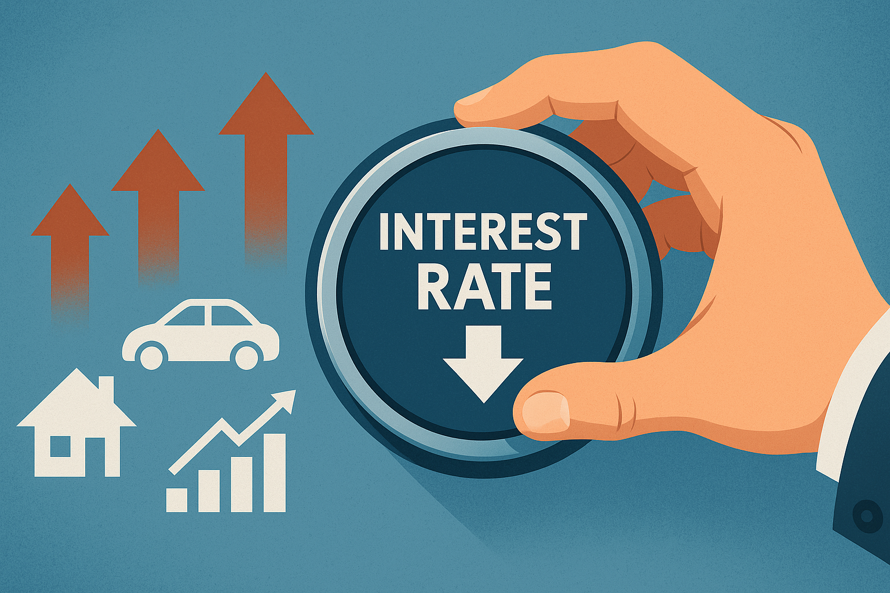
Key Takeaways
- RBI repo rate is now 5.5%, the lowest in years.
- Real estate, auto, IT, and FMCG sectors are set to benefit.
- EMI savings can boost household disposable income.
- Equity markets may see targeted gains rather than broad surges.
On June 6, 2025, the Reserve Bank of India (RBI) slashed the repo rate by 50 basis points to 5.5%—its third rate cut this year. Alongside this, the RBI also reduced the Cash Reserve Ratio (CRR) by 100 basis points to 3%. These moves are part of an aggressive push to boost domestic demand amid global headwinds, and their ripple effects could touch nearly every corner of the Indian economy—from home loans to stock markets.
Here’s what you need to know, whether you’re a homeowner, investor, or business decision-maker.
Why Did RBI Cut Rates Again?
This 50 bps repo rate cut follows two earlier cuts of 25 bps each in February and April. That’s a full 1% drop in 2025 so far—a rare and bold sequence of moves.
The reasons?
- Global uncertainty: Tariff threats from the U.S., slowing demand from China, and oil above $88/barrel.
- Financial volatility: Rising bond yield spreads and inflation worries.
- Domestic push: The RBI aims to make borrowing cheaper, boost liquidity, and spark consumption and investment.
By lowering the repo rate (the interest at which RBI lends to commercial banks), the central bank is making it easier and cheaper for banks to lend money to consumers and businesses.
Sector-Wise Impact: Who Stands to Gain?
According to market analysts and data from the report, several key sectors could benefit:
Real Estate
- Impact: Home loans are cheaper, improving EMI-to-income ratios.
- Insight: Developers are holding over 4.5 lakh unsold units. Tier 2 and 3 housing may grow by 14% YoY.
Automobiles
- Impact: Lower EMIs could spark demand for entry-level cars, tractors, and two-wheelers.
- Data point: Passenger vehicle bookings rose 11% YoY after the February rate cut.
Banking
- Impact: Banks may face pressure on margins but could see 10–12% credit growth, especially from retail and MSMEs.
- Note: NBFCs (non-banking finance companies) are likely to gain faster due to quicker transmission.
FMCG and Consumer Durables
- Impact: Lower EMIs can drive higher discretionary spending.
- Trend: Rural FMCG sales grew 6% in Q1 2025. Appliances like ACs and TVs saw a 20–25% bump.
IT and Exports
- Impact: A weaker rupee (₹86.6 per USD) makes Indian exports more attractive.
- Positive sectors: IT, pharmaceuticals, and chemicals.
Infrastructure
- Impact: With borrowing costs at a 3-year low, capex is likely to rise.
- Support: ₹111 lakh crore in infra projects under Gati Shakti.
What Does This Mean for the Stock Market?
Rather than broad rallies, expect sector-specific upswings:
- Realty and consumer durables jumped by over 1% after the February cut.
- Bond yields dropped to 6.44%, making debt investments more attractive.
- Likely winners include DLF, Sobha, Godrej Properties (real estate) and Infosys, TCS (IT).
Note: These are observations, not investment advice.
Personal Finance Impact: EMIs Just Got Lighter
For the average borrower, the benefits are real:
- A ₹36 lakh home loan over 30 years sees EMI drop from ₹28,651 to ₹27,446.
- That’s a monthly saving of ₹1,205, or over ₹1.2 lakh across 5 years.
- This leaves more disposable income, which often feeds into discretionary spending.
Expert Take: Is This the Last Cut for 2025?
- Capitalmind analysts see this as a pro-growth pivot that could support rate-sensitive sectors for the next 6–12 months.
- Reuters suggests this may be the final rate cut for 2025.
- Kanika Singh (IMGC) believes the move aligns with a declining inflation trend.
Final Thoughts: What Should You Do?
The RBI’s twin move—cutting both repo and CRR—is a clear signal of stimulus. For consumers, this means cheaper loans and better deals. For businesses, it’s easier access to credit. And for investors, it means watching which sectors benefit most and adjusting accordingly.
However, always consult a qualified advisor before making financial or investment decisions.
FAQs
Q: Will loan EMIs fall immediately?
A: Most floating-rate loans will reflect the change in the next cycle. Fixed-rate loans won’t.
Q: Is this a good time to take a home loan?
A: Yes, rates are attractive. But ensure affordability, not just eligibility.
Q: How does this impact FD rates?
A: Banks may reduce FD interest rates gradually. Consider locking in current high rates if you prefer fixed income.




